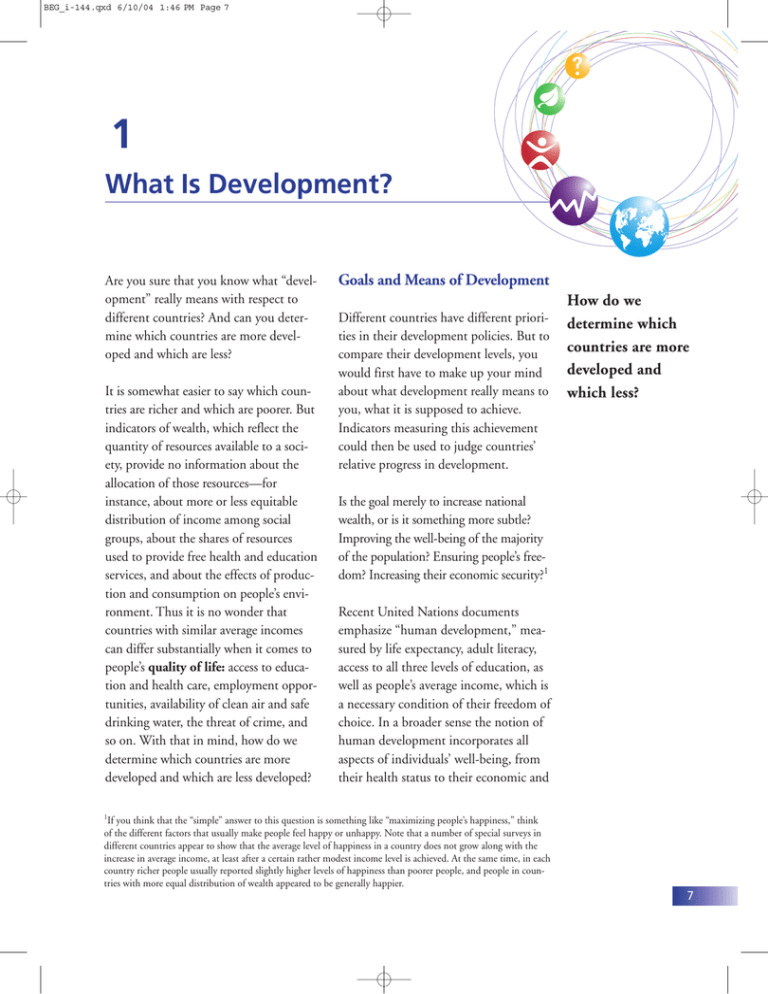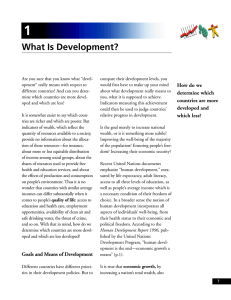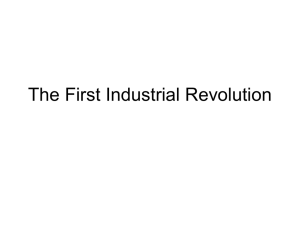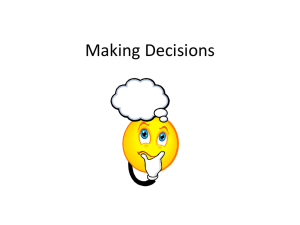What is Development? Human Development & Sustainability
advertisement

BEG_i-144.qxd 6/10/04 1:46 PM Page 7 1 What Is Development? Are you sure that you know what “development” really means with respect to different countries? And can you determine which countries are more developed and which are less? It is somewhat easier to say which countries are richer and which are poorer. But indicators of wealth, which reflect the quantity of resources available to a society, provide no information about the allocation of those resources—for instance, about more or less equitable distribution of income among social groups, about the shares of resources used to provide free health and education services, and about the effects of production and consumption on people’s environment. Thus it is no wonder that countries with similar average incomes can differ substantially when it comes to people’s quality of life: access to education and health care, employment opportunities, availability of clean air and safe drinking water, the threat of crime, and so on. With that in mind, how do we determine which countries are more developed and which are less developed? Goals and Means of Development Different countries have different priorities in their development policies. But to compare their development levels, you would first have to make up your mind about what development really means to you, what it is supposed to achieve. Indicators measuring this achievement could then be used to judge countries’ relative progress in development. How do we determine which countries are more developed and which less? Is the goal merely to increase national wealth, or is it something more subtle? Improving the well-being of the majority of the population? Ensuring people’s freedom? Increasing their economic security?1 Recent United Nations documents emphasize “human development,” measured by life expectancy, adult literacy, access to all three levels of education, as well as people’s average income, which is a necessary condition of their freedom of choice. In a broader sense the notion of human development incorporates all aspects of individuals’ well-being, from their health status to their economic and 1 If you think that the “simple” answer to this question is something like “maximizing people’s happiness,” think of the different factors that usually make people feel happy or unhappy. Note that a number of special surveys in different countries appear to show that the average level of happiness in a country does not grow along with the increase in average income, at least after a certain rather modest income level is achieved. At the same time, in each country richer people usually reported slightly higher levels of happiness than poorer people, and people in countries with more equal distribution of wealth appeared to be generally happier. 7 BEG_i-144.qxd 6/10/04 1:46 PM Page 8 BEYOND ECONOMIC GROWTH political freedom. According to the Human Development Report 1996, published by the United Nations Development Program, “human development is the end—economic growth a means.” It is true that economic growth, by increasing a nation’s total wealth, also enhances its potential for reducing poverty and solving other social problems. But history offers a number of examples where economic growth was not followed by similar progress in human development. Instead growth was achieved at the cost of greater inequality, higher unemployment, weakened democracy, loss of cultural identity, or overconsumption of natural resources needed by future generations. As the links between economic growth and social and environmental issues are better understood, experts including economists tend to agree that this kind of growth is inevitably unsustainable—that is, it cannot continue along the same lines for long. First, if environmental and social/human losses resulting from economic growth turn out to be higher than economic benefits (additional incomes earned by the majority of the population), the overall result for people’s wellbeing becomes negative. Thus such economic growth becomes difficult to sustain politically. Second, economic growth itself inevitably depends on its natural and social/human conditions. To be sustainable, it must rely on a certain amount of natural resources and services 8 provided by nature, such as pollution absorption and resource regeneration. Moreover, economic growth must be constantly nourished by the fruits of human development, such as higher qualified workers capable of technological and managerial innovations along with opportunities for their efficient use: more and better jobs, better conditions for new businesses to grow, and greater democracy at all levels of decisionmaking (see Fig. 1.1). Conversely, slow human development can put an end to fast economic growth. According to the Human Development Report 1996, “during 1960–1992 not a single country succeeded in moving from lopsided development with slow human development and rapid growth to a virtuous circle in which human development and growth can become mutually reinforcing.” Since slower human development has invariably been followed by slower economic growth, this growth pattern was labeled a “dead end.” Sustainable Development Sustainable development is a term widely used by politicians all over the world, even though the notion is still rather new and lacks a uniform interpretation. Important as it is, the concept of sustainable development is still being developed and the definition of the term is constantly being revised, extended, BEG_i-144.qxd 6/10/04 1:46 PM Page 9 1 WHAT IS DEVELOPMENT? Why is equity important for sustainable development? and refined. Using this book, you can try to formulate your own definition as you learn more about the relationships among its main components—the economic, social, and environmental factors of sustainable development—and as you decide on their relative significance based on your own system of values. According to the classical definition given by the United Nations World Commission on Environment and Development in 1987, development is sustainable if it “meets the needs of the present without compromising the ability of future generations to meet their own needs.” It is usually understood that this “intergenerational” equity would be impossible to achieve in the absence of present-day social equity , if the economic activities of some groups of peo- ple continue to jeopardize the well-being of people belonging to other groups or living in other parts of the world. Imagine, for example, that emissions of greenhouse gases, generated mainly by highly industrialized countries, lead to global warming and flooding of certain low-lying islands—resulting in the displacement and impoverishment of entire island nations (see Chapter 14). Or consider the situation when higher profits of pharmaceutical companies are earned at the cost of millions of poor people being unable to afford medications needed for treating their life-threatening diseases. “Sustainable” development could probably be otherwise called “equitable and balanced,” meaning that, in order for development to continue indefinitely, it should balance the interests of different 9 BEG_i-144.qxd 6/10/04 1:46 PM Page 10 BEYOND ECONOMIC GROWTH groups of people, within the same generation and among generations, and do so simultaneously in three major interrelated areas–economic, social, and environmental. So sustainable development is about equity, defined as equality of opportunities for well-being, as well as about comprehensiveness of objectives. Figure 1.2 shows just a few of the many objectives, which, if ignored, threaten to slow down or reverse development in other areas. You are invited to add more objectives and explain how, in your opinion, they are connected to others. In the following chapters you will find many examples of such interconnections. Obviously, balancing so many diverse objectives of development is an enormous challenge for any country. For instance, how would you compare the positive 10 value of greater national security with the negative value of slower economic growth (loss of jobs and income) and some, possibly irreversible, environmental damage? There is no strictly scientific method of performing such valuations and comparisons. However, governments have to make these kinds of decisions on a regular basis. If such decisions are to reflect the interests of the majority, they must be taken in the most democratic and participatory way possible. But even in this case, there is a high risk that long-term interests of our children and grandchildren end up unaccounted for, because future generations cannot vote for themselves. Thus, to ensure that future generations inherit the necessary conditions to provide for their own welfare, our presentday values must be educated enough to reflect their interests as well. BEG_i-144.qxd 6/10/04 1:46 PM Page 11 1 WHAT IS DEVELOPMENT? The challenge is further complicated by the fact that in today’s interdependent world many aspects of sustainable development are in fact international or even global. On the one hand, many decisions taken at the national or even local level actually have international consequences–economic, social, environmental. When these consequences are negative, the situation is sometimes referred to as “exporting unsustainability.” On the other hand, national policies are often inadequate to effectively deal with many challenges of sustainability. Thus international cooperation on the wide range of so-called transboundary and global problems of sustainable development becomes indispensable. Arguably, the most critical problem of sustainable development—in each country as well as globally—is eradicating extreme poverty. That is because poverty is not only an evil in itself. It also stands in the way of achieving most other goals of development, from clean environment to personal freedom. Another, closely related, global problem is establishing and preserving peace in all regions and all countries. War, as well as poverty, is inherently destructive of all economic as well as social and environmental goals of development (see Fig. 1.2). In the final analysis sustainable development is about long-term conditions for humanity’s multidimensional well-being. For example, the famous Rio Declaration, adopted by the United Nations Conference on Environment and Development in 1992 (also called the Earth Summit, held in Rio de Janeiro, Brazil), puts it this way: “Human beings are at the center of concern for sustainable development. They are entitled to a healthy and productive life in harmony with nature.” What are the necessary conditions for sustainable development? 11





